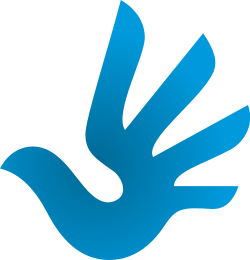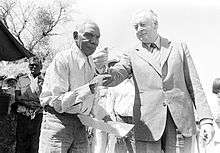Indigenous rights
Indigenous rights are those rights that exist in recognition of the specific condition of the indigenous peoples. This includes not only the most basic human rights of physical survival and integrity, but also the rights over their land (including native title), language, religion, and other elements of cultural heritage that are a part of their existence and identity as a people. This can be used as an expression for advocacy of social organizations, or form a part of the national law in establishing the relation between a government and the right of self-determination among its indigenous people, or in international law as a protection against violation of indigenous rights by actions of governments or groups of private interests.
| Rights |
|---|
 |
| Theoretical distinctions |
| Human rights |
| Rights by beneficiary |
| Other groups of rights |
| Part of a series on |
| Indigenous rights |
|---|
| Rights |
| Governmental organizations |
| NGOs and political groups |
| Issues |
| Legal representation |
| Category |

Definition and historical background
Indigenous rights belong to those who, being indigenous peoples, are defined by being the original people of a land that has been conquered and colonized by outsiders.[2][3][4][5]
Exactly who is a part of the indigenous peoples is disputed, but can broadly be understood in relation to colonialism. When we speak of indigenous peoples we speak of those pre-colonial societies that face a specific threat from this phenomenon of occupation, and the relation that these societies have with the colonial powers. The exact definition of who are the indigenous people, and the consequent state of rightsholders, varies. Being too inclusive is considered as bad as being non-inclusive.[5][6]
In the context of modern indigenous people of European colonial powers, the recognition of indigenous rights can be traced to at least the period of Renaissance. Along with the justification of colonialism with a higher purpose for both the colonists and colonized, some voices expressed concern over the way indigenous peoples were treated and the effect it had on their societies.[7] In the Spanish Empire, the crown established the General Indian Court in Mexico and in Peru, with jurisdiction over cases involving the indigenous and aimed at protecting Indians from ill-treatment. Indians' access to the court was enabled by a small tax which paid for legal aides.[8][9]
The issue of indigenous rights is also associated with other levels of human struggle. Due to the close relationship between indigenous peoples' cultural and economic situations and their environmental settings, indigenous rights issues are linked with concerns over environmental change and sustainable development.[10][11][12] According to scientists and organizations like the Rainforest Foundation, the struggle for indigenous peoples is essential for solving the problem of reducing carbon emission, and approaching the threat on both cultural and biological diversity in general.[13][14][15]
Representation
The rights, claims and even identity of indigenous peoples are apprehended, acknowledged and observed quite differently from government to government. Various organizations exist with charters to in one way or another promote (or at least acknowledge) indigenous aspirations, and indigenous societies have often banded together to form bodies which jointly seek to further their communal interests.
International organizations
There are several non-governmental civil society movements, networks, indigenous and non-indigenous organizations whose founding mission is to protect indigenous rights, including land rights.[16] These organizations, networks and groups underline that the problems that indigenous peoples are facing is the lack of recognition that they are entitled to live the way they choose, and lack of the right to their lands and territories. Their mission is to protect the rights of indigenous peoples without states imposing their ideas of "development".[17] These groups say that each indigenous culture is differentiated, rich of religious believe systems, way of life, sustenance and arts, and that the root of problem would be the interference with their way of living by state's disrespect to their rights, as well as the invasion of traditional lands by multinational corporations and small businesses for exploitation of natural resources.[18]
United Nations
Indigenous peoples and their interests are represented in the United Nations primarily through the mechanisms of the Working Group on Indigenous Populations. In April 2000 the United Nations Commission on Human Rights adopted a resolution to establish the United Nations Permanent Forum on Indigenous Issues (PFII) as an advisory body to the Economic and Social Council with a mandate to review indigenous issues.
In late December 2004, the United Nations General Assembly proclaimed 2005–2014 to be the Second International Decade of the World's Indigenous People. The main goal of the new decade will be to strengthen international cooperation around resolving the problems faced by indigenous peoples in areas such as culture, education, health, human rights, the environment, and social and economic development.
In September 2007, after a process of preparations, discussions and negotiations stretching back to 1982, the General Assembly adopted the Declaration on the Rights of Indigenous Peoples. The non-binding declaration outlines the individual and collective rights of indigenous peoples, as well as their rights to identity, culture, language, employment, health, education and other issues. Four nations with significant indigenous populations voted against the declaration: the United States, Canada, New Zealand and Australia. All four have since then changed their vote in favour. Eleven nations abstained: Azerbaijan, Bangladesh, Bhutan, Burundi, Colombia, Georgia, Kenya, Nigeria, Russia, Samoa and Ukraine. Thirty-four nations did not vote, while the remaining 143 nations voted for it.
ILO 169
ILO 169 is a convention of the International Labour Organization. Once ratified by a state, it is meant to work as a law protecting tribal people's rights. There are twenty-two physical survival and integrity, but also the preservation of their land, language and religion rights. The ILO is represents indigenous rights as they are the organisation that enforced instruments the deal with indigenous rights exclusively.[19]
Organization of American States
Since 1997, the nations of the Organization of American States have been discussing draft versions of a proposed American Declaration on the Rights of Indigenous Peoples.[20] "The draft declaration is currently one of the most important processes underway with regard to indigenous rights in the Americas"[21] as mentioned by the International Work Group for Indigenous Affairs.
By country
Australia
Early campaigners in South Australia included Charles and Phyllis Duguid.
Canada
In Canada "Aboriginal rights" (French: droits ancestraux) are those rights that indigenous peoples enjoy as a result of their ancestors' long occupancy of the land, for example the right to hunt and fish a particular territory.[22] These are distinct from "treaty rights" which are enumerated in specific agreements between indigenous groups and the state. Both treaty rights and Aboriginal rights are protected by Section 35 of the Canadian constitution of 1982.
See also
References
- Australia, National Museum of. "Collaborating for Indigenous Rights Home". indigenousrights.net.au. Archived from the original on 2016-05-05. Retrieved 2016-05-17.
- Lindholt, Lone (2005). Human Rights in Development Yearbook 2003: Human Rights and Local/living Law. Martinus Nijhoff Publishers. ISBN 90-04-13876-5.
- Gray, Andrew (2003). Indigenous Rights and Development: Self-Determination in an Amazonian Community. Berghahn Books. ISBN 1-57181-837-5.
- Keal, Paul (2003). European Conquest and the Rights of Indigenous Peoples: The Moral Backwardness of International Society. Cambridge University Press. ISBN 0-521-82471-0.
- Kuppe, Rene (2005). "Indigenous Peoples, Constitutional States And Treaties Of Other Constructive Arrangements Between Indigenous Peoples And States". Brill Academic Publishers. ISBN 90-04-14244-4.
- "Recognizing Indigenous Peoples' Human Rights". Cultural Survival. Archived from the original on 11 January 2012. Retrieved 20 April 2016.
- Anaya, S. James (2004). Indigenous Peoples in International Law. Oxford University Press. ISBN 0-19-517350-3.
- Woodrow Borah, The General Indian Court of Mexico and the Legal Aides of the Half-Real. Berkeley and Los Angeles: University of California Press 1983.
- Woodrow Borah, "Juzgado General de Indios del Perú o juzgado particular de indios de El Cercado de Lima." Revista chilena de historia del derecho, no. 6 (1970): 129-142.
- "Rights of Indigenous Peoples". Archived from the original on 23 September 2015. Retrieved 20 April 2016.
- "Indigenous Rights and Responsibilities for the Natural World". Archived from the original on 25 November 2015. Retrieved 20 April 2016.
- "University of Oregon School of Law" (PDF). Archived from the original (PDF) on 3 March 2016. Retrieved 20 April 2016.
- "Indigenous Rights Crucial To Reducing Carbon Emissions from Deforestation". TreeHugger. Archived from the original on 20 August 2011. Retrieved 20 April 2016.
- Stevens, Stanley (1997). Conservation through cultural survival: indigenous peoples and protected areas. Island Press. ISBN 1-55963-449-9.
- United Nations, State of The World's Indigenous Peoples Archived February 15, 2010, at the Wayback Machine – UNPFII report, First Issue, 2009
- Earth Peoples
- Survival International. "About us". Archived from the original on 17 September 2009. Retrieved 20 April 2016.
- "International Indian Treaty Council". iitc.org. Retrieved 20 April 2016.
- "Indigenous and tribal peoples". www.ilo.org. Archived from the original on 2016-05-08. Retrieved 2016-05-17.
- Website of the Proposed American Declaration on the Rights of Indigenous Peoples Archived 2013-05-25 at the Wayback Machine
- Hansen, Jens Søgaard. "Organisation of American States". www.iwgia.org. Archived from the original on 2016-06-04. Retrieved 2016-05-17.
- Branch, Government of Canada; Indigenous and Northern Affairs Canada; Communications. "Aboriginal Rights". www.aadnc-aandc.gc.ca. Archived from the original on 17 April 2018. Retrieved 4 May 2018.
External links
| Library resources about Indigenous rights |
- The Rights of Indigenous Peoples: Study Guide – University of Minnesota
- Researching Indigenous People's Rights Under International Law – Steven C. Perkins
- Indigenous Rights – International Encyclopedia of the Social Sciences, 2nd Edition
- United Nations Declaration on the Rights of Indigenous Peoples
- ILO Convention 169 (full text) - Current international law on indigenous peoples
- State of The World's Indigenous Peoples – UN report, First Issue, 2009
- Genocide Lewis, Norman, February 1969 - Article that led to the foundation of several prominent indigenous rights organizations
- Conservation and Community Rights: Lessons from Mesoamerica